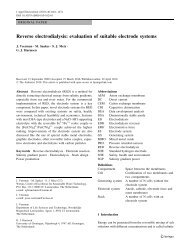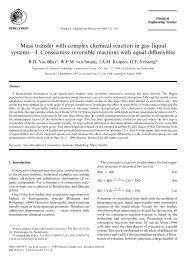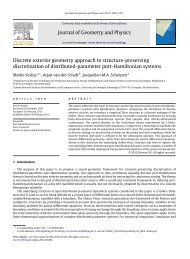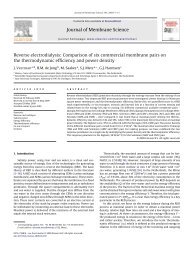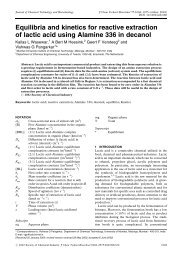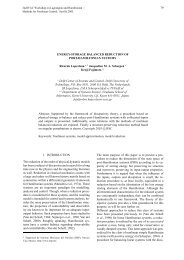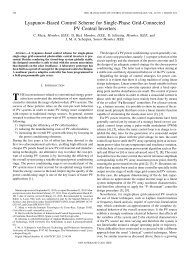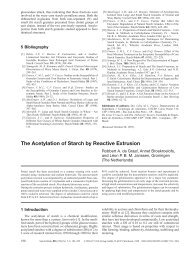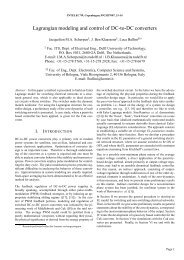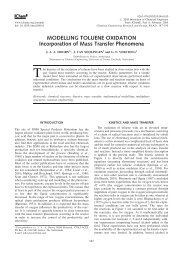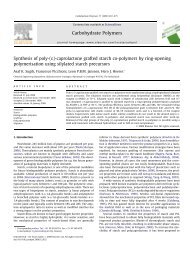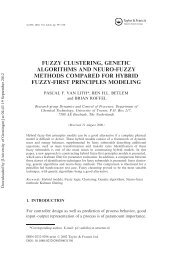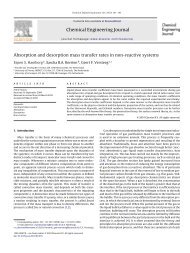Gas-Liquid Mass Transfer Coefficient in Stirred Tank Reactors - ITM
Gas-Liquid Mass Transfer Coefficient in Stirred Tank Reactors - ITM
Gas-Liquid Mass Transfer Coefficient in Stirred Tank Reactors - ITM
Create successful ePaper yourself
Turn your PDF publications into a flip-book with our unique Google optimized e-Paper software.
Table 2. Correlations proposed by different workers to estimate volumetric<br />
gas–liquid mass transfer coefficient (k L a) <strong>in</strong> STR and used <strong>in</strong> the present work.<br />
Researchers Correlation Proposed<br />
Calderbank (1958) van’t Riet k L a = 0.026 (P/V L ) 0.4 (V G ) 0.5<br />
( 1979)<br />
Smith et al. (1977) k L a = 0.01 (P/V L ) 0.475 (V G ) 0.4<br />
Smith and Warmoeskerken BLC regime:<br />
(1985) k L a = 1.1 ¥ 10 –7 (Fl G ) 0.6 (Re N ) 1.1 (N)<br />
ALC regime:<br />
k L a = 1.6 ¥ 10 –7 (Fl G ) 0.42 (Re N ) 1.02 (N)<br />
L<strong>in</strong>ek et al. (1987) k L a = 4.95 ¥ 10 –3 (P/V L ) 0.593 (V G ) 0.4<br />
Hickman (1988) For T = 0.60 m<br />
k L a = 0.043 (P/V L ) 0.4 (V G ) 0.57<br />
For T = 2 m<br />
k L a = 0.027 (P/V L ) 0.54 (V G ) 0.68<br />
Smith (1991) k L a = 1.25 ¥ 10 –4 (D/T) 2.8<br />
(Fr) 0.6 (Re N ) 0.7<br />
(Fl G ) 0.45 (D/g) –0.5<br />
Whitton and Nienow (1993) k L a = 0.57 (P/m) 0.4 (V G ) 0.55<br />
Zhu et al. (2001) k L a = 0.031 (P/V L ) 0.4 (V G ) 0.5<br />
1993). The last two are objective methods but show good<br />
agreement with the first, which is subjective (Rewatkar and<br />
Joshi, 1993).<br />
Relative <strong>Gas</strong> Dispersion (N/N cd )<br />
Turbulent fluctuations <strong>in</strong> the gas–liquid dispersion control the<br />
drag on the bubble and hence the bubble size (Calderbank<br />
et al., 1959; H<strong>in</strong>ze, 1955; Hughmark 1974; Miller, 1974). The<br />
bubbles break up when the hydrodynamic stresses (Reynolds<br />
Table 3. Hughmark’s (1980) correlation for impeller power <strong>in</strong>put<br />
under aerated condition (PG /PO ) for standard six bladed disc turb<strong>in</strong>e<br />
is based on follow<strong>in</strong>g experimental details.<br />
<strong>Tank</strong> diameter, T (m) 0.21 to 3.33<br />
D/T 0.33 to 0.576<br />
C/T 0.33 to 0.67<br />
H/T 0.75 to 1.87<br />
VG (max.) 0.053 m/s<br />
Blade width (w),m 0.2D<br />
m (mPa·s) 0.8 to 28<br />
r (kg/m3 ) 870 to 1600<br />
s (g/s2 ) 25 to 72<br />
PG /PO 0.31 to 0.8<br />
stresses) outweigh the surface tension force (H<strong>in</strong>ze, 1955;<br />
Calderbank et al., 1959; Walter and Blanch ,1986). Walter and<br />
Blanch (1986) gave the correlation of maximum stable bubble<br />
size on the assumption that bubble break-up is caused by the<br />
eddies of the same scale as the maximum stable bubble size.<br />
Parthasarathy and Ahmed (1991) have discussed the process of<br />
bubble break-up <strong>in</strong> a turbulent field us<strong>in</strong>g the criterion of power<br />
dissipation accord<strong>in</strong>g to Kolmogoroff’s theory. Accord<strong>in</strong>gly, they<br />
concluded that bubbles are broken by eddies of the <strong>in</strong>ertial subrange.<br />
The turbulence <strong>in</strong>creases the drag on the bubbles (Hughmark,<br />
1974) thereby reduc<strong>in</strong>g the bubble rise velocity. These bubbles<br />
with reduced rise velocity can be more easily entra<strong>in</strong>ed <strong>in</strong> the<br />
downward liquid flow generated by the impeller. Thus, the<br />
overall effect of <strong>in</strong>creas<strong>in</strong>g turbulence results <strong>in</strong> <strong>in</strong>creas<strong>in</strong>g gas<br />
hold-up (e G ) and therefore gas–liquid <strong>in</strong>terfacial surface area (a)<br />
<strong>in</strong> STR.<br />
At N cd complete dispersion of the sparged gas is achieved.<br />
Therefore, from the above discussion it can be concluded that<br />
at N cd the bubble size generated <strong>in</strong> the vic<strong>in</strong>ity of the impeller<br />
has a buoyancy lesser than the downward drag caused by the<br />
downward liquid flow and the bubbles are pulled down <strong>in</strong> the lower<br />
Table 4. Correlations obta<strong>in</strong>ed for the k L a data of different workers based on relative dispersion parameter, N/N cd .<br />
Researchers Correlation based on the term, R2 Standard error Number of data<br />
N/Ncd analyzed<br />
Calderbank (1958), van’t Riet (1979) k L a = 2.76 (N/N cd ) 1.14 (V G ) 0.97 1 - 7<br />
Smith et al. (1977) k L a = 2.42 (N/N cd ) 1.38 (V G ) 0.96 0.98 0.07 41<br />
Chandrasekharan and Calderbank (1981) k L a = 2.68 (N/N cd ) 1.15 (V G ) 0.96 0.99 0.04 11<br />
Smith and Warmoeskerken (1985) k L a =12.63 (N/N cd ) 1.54 (V G ) 1.27 0.99 0.02 15<br />
L<strong>in</strong>ek et al. (1987) k L a = 5.16 (N/N cd ) 1.69 (V G ) 1.09 1 - 7<br />
Hickman (1988) k L a = 4.28 (N/N cd ) 1.35 (V G ) 1.04 0.97 0.12 21<br />
Smith (1991) k L a = 6.48 (N/N cd ) 1.44 (V G ) 1.12 0.99 0.02 32<br />
Whitton and Nienow (1993) k L a = 3.50 (N/N cd ) 1.17 (V G ) 0.99 0.02 13<br />
Bakker and van den Akker (1994) k L a = 0.030 (N/N cd ) 1.42 0.93 0.10 16<br />
Zhu et al. (2001) k L a = 3.31 (N/N cd ) 1.14 (V G ) 0.97 1 - 15<br />
842 The Canadian Journal of Chemical Eng<strong>in</strong>eer<strong>in</strong>g, Volume 80, October 2002



